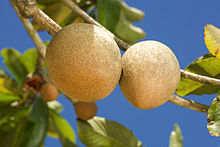| Mamey sapote | |
|---|---|

| |
| Scientific classification | |
| Kingdom: | Plantae |
| Clade: | Tracheophytes |
| Clade: | Angiosperms |
| Clade: | Eudicots |
| Clade: | Asterids |
| Order: | Ericales |
| Family: | Sapotaceae |
| Genus: | Pouteria |
| Species: | P. sapota
|
| Binomial name | |
| Pouteria sapota | |
| Synonyms[2] | |
| Nutritional value per 100 g (3.5 oz) | |||||||||||||||||||||||||||||||||||||||||||||
|---|---|---|---|---|---|---|---|---|---|---|---|---|---|---|---|---|---|---|---|---|---|---|---|---|---|---|---|---|---|---|---|---|---|---|---|---|---|---|---|---|---|---|---|---|---|
| Energy | 520 kJ (120 kcal) | ||||||||||||||||||||||||||||||||||||||||||||
32.1 g | |||||||||||||||||||||||||||||||||||||||||||||
| Sugars | 20.14 g | ||||||||||||||||||||||||||||||||||||||||||||
| Dietary fiber | 5.4 g | ||||||||||||||||||||||||||||||||||||||||||||
0.46 g | |||||||||||||||||||||||||||||||||||||||||||||
1.45 g | |||||||||||||||||||||||||||||||||||||||||||||
| |||||||||||||||||||||||||||||||||||||||||||||
| †Percentages estimated using US recommendations for adults,[3] except for potassium, which is estimated based on expert recommendation from the National Academies.[4] | |||||||||||||||||||||||||||||||||||||||||||||
Pouteria sapota, the mamey sapote, is a species of tree native to Mexico and Central America. The tree is also cultivated in the Caribbean. Its fruit is eaten in many Latin American countries. The fruit is made into foods such as milkshakes and ice cream.
Some of its names in Latin American countries, such as mamey colorado (Cuba), zapote colorado (Costa Rica) and zapote rojo (South America), refer to the reddish colour of its flesh to distinguish it from the unrelated but similar-looking Mammea americana, whose fruit is usually called "yellow mamey" (Spanish: mamey amarillo).[citation needed]
The Australian and Queensland governments' research and development programs have grown mamey sapote in Australia.
- ^ Botanic Gardens Conservation International (BGCI) & IUCN SSC Global Tree Specialist Group (2021). "Pouteria sapota". IUCN Red List of Threatened Species. 2021: e.T150102002A150108560. doi:10.2305/IUCN.UK.2021-1.RLTS.T150102002A150108560.en. Retrieved 25 March 2022.
- ^ "The Plant List".
- ^ United States Food and Drug Administration (2024). "Daily Value on the Nutrition and Supplement Facts Labels". FDA. Archived from the original on 2024-03-27. Retrieved 2024-03-28.
- ^ National Academies of Sciences, Engineering, and Medicine; Health and Medicine Division; Food and Nutrition Board; Committee to Review the Dietary Reference Intakes for Sodium and Potassium (2019). Oria, Maria; Harrison, Meghan; Stallings, Virginia A. (eds.). Dietary Reference Intakes for Sodium and Potassium. The National Academies Collection: Reports funded by National Institutes of Health. Washington, DC: National Academies Press (US). ISBN 978-0-309-48834-1. PMID 30844154. Archived from the original on 2024-05-09. Retrieved 2024-06-21.
